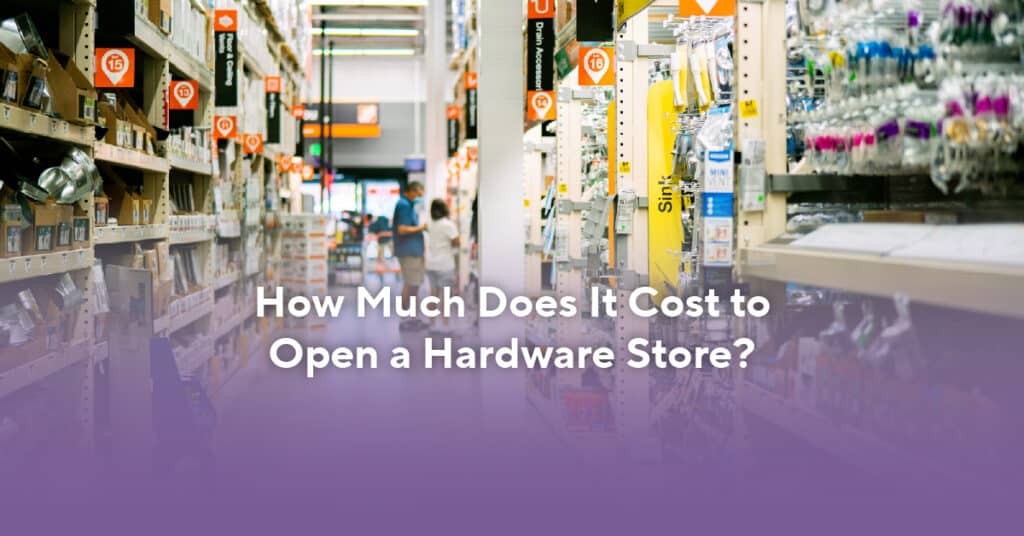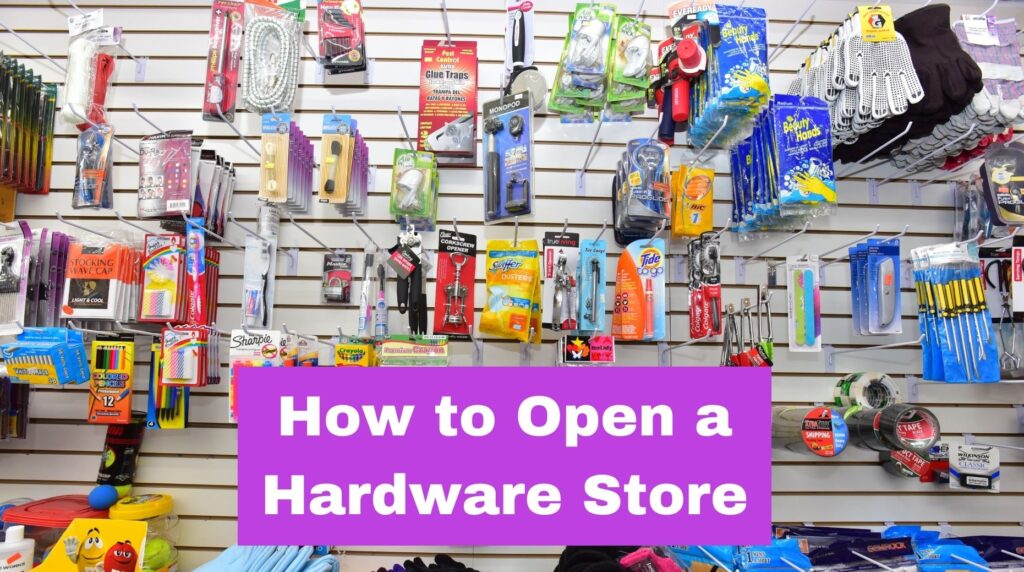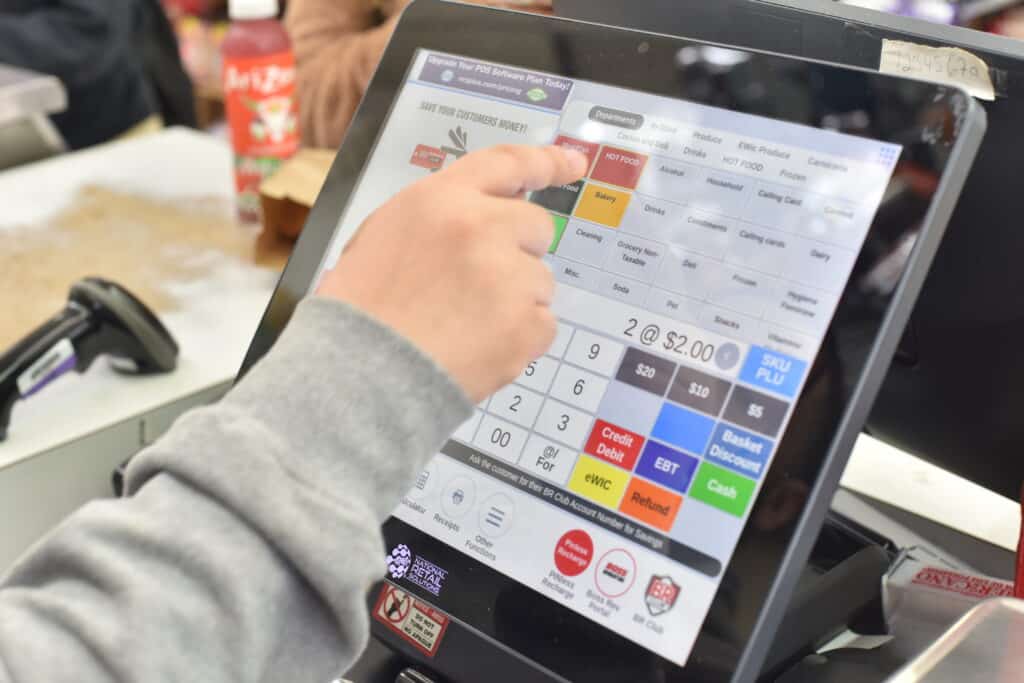When more than 80 percent of consumers surveyed last year stated they’re loyal to brands — and therefore buy only from those brands — a business owner’s mind should start churning.
In particular, small businesses or family-owned operations have a lot to gain from increasing customer loyalty. Aside from driving stronger sales, a sense of loyalty builds a relationship with your business well beyond the checkout counter. It keeps your small business top-of-mind, deepens positive impressions and increases the perceived value of your products or services — all because you’ve tapped into someone’s sense of familiarity and commitment.
With an active loyalty program, you can achieve this. This business strategy works to encourage and reward frequent interactions between you and a target customer. The more a customer shops and purchases, the more rewards they rack up.
Yet the value of a customer loyalty program for small businesses doesn’t stop there — not to mention, there are many types of loyalty incentives you can set up. Read on to learn the pros and cons of some of today’s most effective small business rewards programs and how they benefit both you and your customers.
1. Referral Incentive Programs
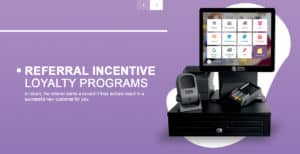
Referral incentives are an outstanding way to activate your current consumer base and gain fresh, cost-effective leads. They’re also relatively straightforward, as their premise relies on basic word-of-mouth principles — a customer recommends your business or product to someone else, and you receive a notice of the recommendation. In return, the referrer earns a reward if their actions result in a successful new customer for you.
Most small businesses set up referral programs on their websites, using a specific page or online form a customer fills out with their contact information and the information of the friend, family member or associate they think will benefit from your services.
You can highlight this page across your website and social media channels, with direct links that make it easy for someone to find. It should be just as easy for someone to see what they’ll potentially earn as a result of the referral, be it a store coupon, gift cards or unique insider merchandise.
Referral programs work well because they check two business boxes. First, you are practicing a highly cost-effective form of lead generation without spending a lot of money. Second, referrals signal you already have some hyper-committed customers who love you so much, they freely tell others about you. The power of recommendations from trusted sources remains the strongest form of advertising today. Referral programs set the standard for this.
Pros of Referral Incentives

- Instantly boost your business’ trust factor and reputation in front of a new audience
- Costs up to 90 percent less than traditional forms of advertising
- Produces higher lifetime-value customers than traditional forms of advertising, with referred customers spending, on average, 13 percent more annually than regular customers
- Doubly rewards your current customers — a tangible gift, plus the psychological boost that they’re helping friends and family
- Twofold rewards your potential new customer — incentivize them with a first-time shopper discount of their own, on top of instilling the feeling of being sought after
Cons of Referral Incentives

- Are typically short-term, incentivizing early connection over retention
- Usually little incentive after that first collaboration
- No guarantee the referred individual will turn into a repeat customer
2. Punch Card Programs
Punch cards are another leading marketing strategy to keep customers physically and emotionally returning to your small business. That’s because they’re one of the most concrete approaches to cultivate loyalty, offering a way for people to see real progress after each purchase and work toward a defined goal.
Loyalty cards work in several different formats. The most common cards are hole-punched or stamp-based, meaning customers receive a business card that gets a hole, ink stamp or some other physical marker recording the number of commercial transactions. After they earn enough punches or purchases, cardholders receive a freebie.
Punch cards work particularly well for restaurants and hospitality services, from coffee shops and bakeries to nail salons and spas. That’s because every time a customer stops in and buys a latte or gets a pedicure, they also receive a mark. Those marks add up, encouraging that individual to use your business and only your business to satisfy a particular need.
More and more, businesses are using digital punch cards to complement this tactic as well. If you have a website that sells merchandise alongside a physical storefront, make sure punch cards are somehow digitally compatible, perhaps with a card account number they can input at checkout. That way, no matter how a returning customer chooses to engage with you, that support gets recognized.
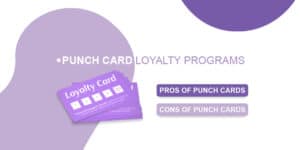
Pros of Punch Cards
- Increased customer retention rates, as a first-time patron has an immediate incentive to return.
- Increased sales as individuals look to work through their cards. The faster they do, the faster they earn a free good or service.
- Opportunities for greater product awareness and promotion. For example, say you’re a food truck owner with a new line of desserts on the menu. Cardholders can get an additional stamp if they purchase a dessert, which in turn means future chances of cross-selling since the customer is now familiar with the new product.
Cons of Punch Cards
- Higher chance of customer incidents or complaints if transactions get missed or physical cards get lost
- Glean few marketing insights or purchasing data from your customers, beyond these routine transactions
- Difficult business balance to strike between giving customers freebies they would already buy on their own and persuading them to invest in goods and services they typically wouldn’t
3. Cash-Back Programs
Cash-back loyalty programs have thrived in industries like retail and finance for decades, thanks to the straightforward and stable rewards model they offer. Just as their name suggests, cash-back programs give customers money back in exchange for spending on certain items or services. These can be anything from plane tickets and denim jeans to running shoes and pet shampoo. The more a customer spends, the more they earn back.
There are two common variations of cash-back loyalty programs. The first is a cash equivalency, which states a customer will get a flat rate of money in return for spending a certain amount. For example, every time a member spends $50, they earn $10 back. They redeem that $10 through vouchers to use when they return to shop.
The second type of cash-back loyalty relies on percentages rather than flat sums. In this program, a loyalty member may earn anywhere between one and five percent return on every purchase they make. These kinds of cash incentives compound and could potentially mean more rewards for a customer, depending on their spending habits, plus offer a sense of autonomy that they can spend as much or as little as they like and still earn rewards.
In essence, both models trade a little extra business for a little extra pocket money, which many consumers have a hard time turning down. They’re easy to install at your registers and point-of-sale systems.
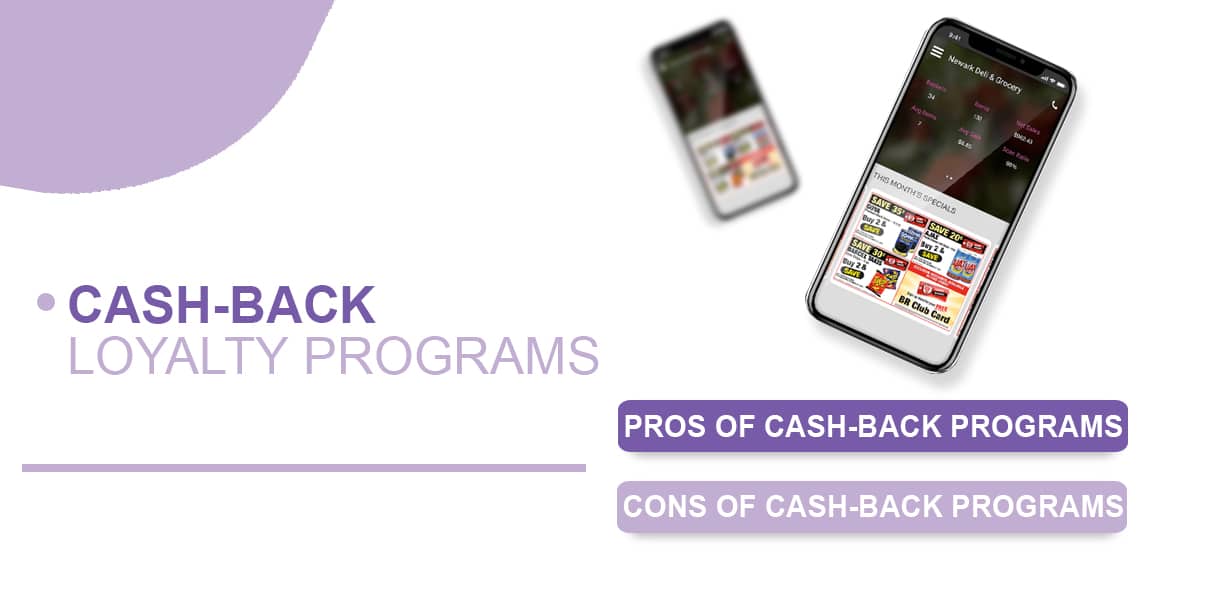
Pros of Cash-Back Programs
- An immediate value proposition, as participants know what they’re earning and can start right away
- A sharpened sense of consumer control, since they get to decide how much they buy and — subsequently — how many rewards they earn
- Easily understandable to the average shopper
- Flexible and adaptable across business models, with the ability to tailor cash-back rewards to different target spenders
- Can integrate into a general content-marketing strategy, since cash-back vouchers typically get sent through email or packaged alongside other promotional materials
Cons of Cash-Back Programs
- Relevant mainly for physical goods and hard products
- Often come with expiration dates for voucher or cash redemption, which may be off-putting to program members who don’t use them in time
- Can be challenging to manage without the proper computerized inventory and sales systems overseeing the program
- Evenly rewards high-lifetime value and low-lifetime value customers alike, which may not be advantageous to the state of your small business
4. Points Programs
Points-based systems remain one of the most popular commercial reward mechanisms on the market. They allow individuals to accrue points the more they shop at or visit your small business, encouraging brand loyalty without seeming pushy or setting voucher limits.
Point systems are intuitive ways to encourage repeat engagement in a clear and understandable format. They also mitigate a few of the problems other customer loyalty programs court, including a lack of ongoing incentives or treating your most valued and your least reliable customers the same.
The simplest of these models rely on an equation that clearly states what a certain number of points translates into. Customers don’t have to mentally wrangle with conversions or calculations on the spot. They already know 10 points equal $1 off their next purchase, or five visits equal a complimentary service.
What’s more, these points equations are open to upgrades. You can track customers who have been in the program longest or individuals with the highest annual points accrual, rewarding them with even further goodies.
Points systems are especially attractive for small businesses looking to beef up their digital presence. You can award points to customers who like your social media pages, share your posts, download your new mobile app or write your business a positive review. That means individuals don’t even necessarily need to stop in for you to reap the benefits of their loyalty. Such cross-packaging advantages to points-based loyalty systems are part of the reason they remain stronger than ever.
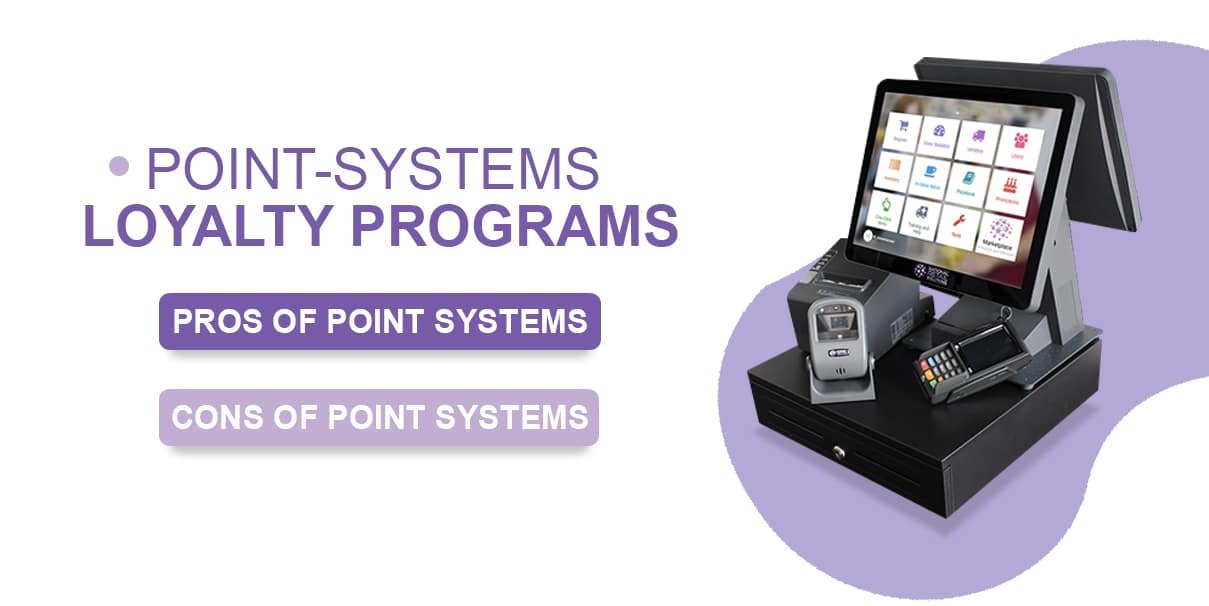
Pros of Point Systems
- Versatility and customization
- Compatible with your marketing campaigns — aside from earning points based on everyday transactions, your small business can create unique promo campaigns, bonus point days and more to further encourage loyalty members’ engagement
- Negates the problem of program free riders, or those who don’t bring in high-value business after signing up for a loyalty program
- Allows you to track purchasing data and customer preferences so you can make more informed business decisions
Cons of Point Systems
- Work best in retail operations and small businesses that process large volumes of smaller, routine transactions, such as gas stations or grocery stores — not necessarily in higher-cost commercial or service-based industries
- Proper storage and oversight of points and points-based rewards
- The saturation of similar loyalty operations among your industry competitors, making your version likely to get lost in the noise
- Overly complicated or rule-stringed point accruals that cause your customers more headaches than happiness
5. Tiered Loyalty Programs
Tiered customer reward programs work by sending bonuses, treats and special offerings to individuals based on their loyalty ranking. That ranking gets based on their history of engagement, from their visits to your small business and their spending amounts to how much they engage with your social media content.
One of the most iconic tiered-customer loyalty examples comes from the coffee conglomerate Starbucks. It’s free to join, and members gain points to unlock the next level of membership. Each of these levels comes with unique features and advantages. It’s a rewards model that mixes bits and pieces from points, cards and cash-back systems alike, yet ultimately aims to drive increased-value customer retention with its highest-level gold membership.
Other tiered programs use a small, up-front membership fee that unlocks the entire range of membership perks right off the bat. Likewise, you can tier these membership subscriptions themselves to let customers pick what level they want to start at — or even go buffet-style, allowing them mix-and-match insider discounts, information and access to exclusive deals at their discretion. The choice is up to your sales-management resources and strategic direction.

Pros of Tiered Customer Programs
- Allows for content marketing cross-promotions — you have access to information like emails and mailing addresses, which you can use to send additional incentivizing material
- Allows for customer segmentation, which means sharper marketing strategies and more tailored promotional opportunities. You send product offerings only to the most relevant membership segment, which increases the chance of your small business seeing a return on its advertising investments.
- Better balance of short-term and long-term reward models — immediate rewards, such as a $5 store coupon, can incentivize joining the tiered program. Yet this model best prioritizes customers who purchase more goods or services at higher values, allowing them to earn a better loyalty ranking and therefore unlock more valuable gifts.
- Gives priority attention to your highest-value clients without sacrificing new or moderately engaged consumers
Cons of Tiered Customer Programs
- Can be easy to forget, especially if customers don’t shop frequently enough to climb the loyalty ladder
- Risks customer dissatisfaction if the length of time between earning and redeeming membership benefits runs too long
- Risks customer dissatisfaction if they get demoted within their membership, which some programs have been known to do
- Can be more time-consuming and expensive to operate and maintain than other loyalty systems
6. Coalition Loyalty Programs
Coalition or partnership programs let you and other businesses in your area work together to drive higher customer retention. Managed collectively by you and the others in the group, the program allows each member business to pool advertising resources and promotional events for the benefit of all. These coalitions might not only share promotions and coupons, but they cross-advertise each other’s deals, share consumer insights and further incentivize visiting the other small businesses in the group.
Coalitions work best in conjunction with technology. Nowadays, many coalitions have customers use swipe cards or download a QR code onto their smartphones, which gives them direct access to the most recent lineup of deals and offerings. The program also allows customers to scan these barcodes and cards at the counter to build up coalition loyalty points — a double perk for your small business since you can opt to share subsequent consumer data among your partners and make better business decisions.
While not required, coalition loyalty programs gain quicker traction if you can team up with complementary businesses in your area. While these businesses don’t have to be in your exact line of work, they should intuitively appeal to the same kinds of customers. For example, say you own a deli and are looking to draw in more foot traffic. You might consider partnering with a neighborhood bakery, a nearby gas station or perhaps even the convenience store down the road. These places already appeal to your everyday shopper and mean immediate cross-promotional opportunities.
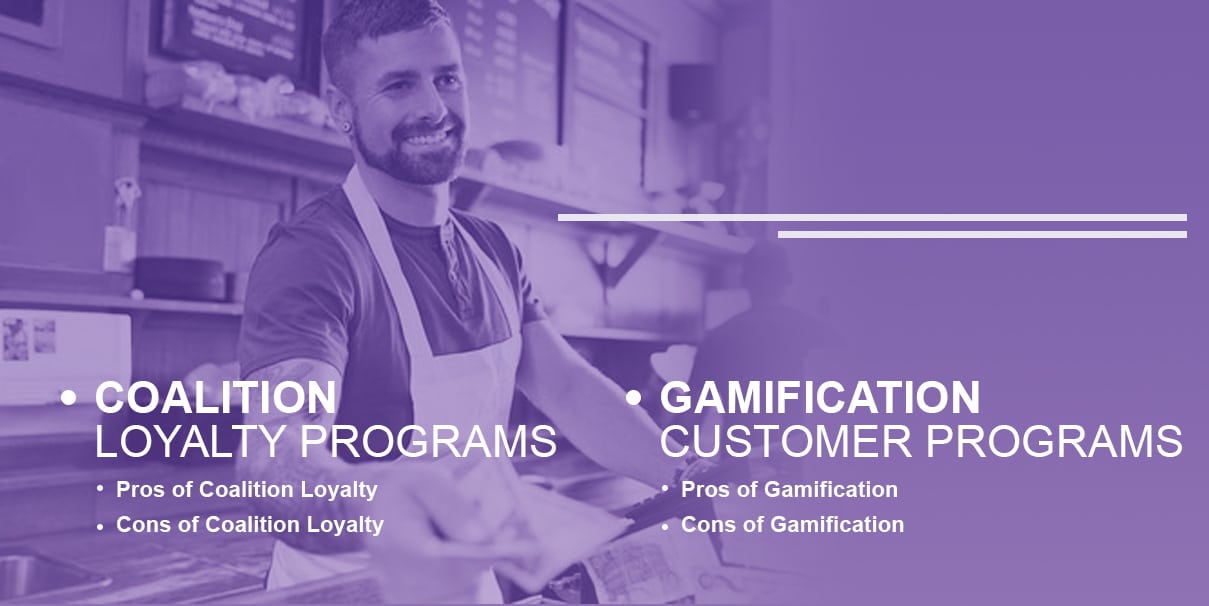
Pros of Coalition Loyalty
- Broader brand awareness and reach
- Freedom and flexibility for your customers
- The ability for those customers to earn their rewards or discounts more quickly
- Knowledge of a tremendous amount of customer spending habits and behaviors — well more than you could learn on your own
- A boost in the community’s positive perception of your small business
Cons of Coalition Loyalty
- Lack of complete program autonomy — the coalition must approve all details, promotions and communications as mutually beneficial for all
- Customers may earn points with you but want to use them elsewhere
- Higher operating costs without the right business infrastructure, like computers or software, plus higher exit costs if you chose to leave the program
- The program can be legally and logistically tricky to set up
7. Gamification Programs
A fancy word for a powerful program, gamification is the process in which businesses use games and gaming strategies to motivate customer commitment. And while the term might be new, the application is not. Nearly 87 percent of retailers in a North American survey had gamification principles on their mind and intended to use them to engage more customers in the upcoming five years.
If this sounds off-brand for your market, think again. There are many ways your small business probably uses gamification already without realizing it. In fact, any attempt you’ve made to drum up attention, brand narratives, inspire competition or instill rewards could be taking cues from game elements, often with surprising effects.
Features like checking in to your business online, assigning badges for frequent customers or enacting a prize drawing or annual giveaway at your point-of-sales register system are all based in gamification. They allow consumers to feel both special and accomplished, that their time and attention with your small business has the potential to turn into something more. By weaving gamification strategies into your business’ marketing model, you can tap into this consumer drive, channeling it into brand evangelism and encouraging further action.
Pros of Gamification
- Better understand the motivations, reactions and emotions of your customers
- Craft communications with a more distinct brand personality
- Cultivate a two-way relationship with consumers who see their happiness and success as tied to yours
Cons of Gamification
- Requires a strong digital fluency and presence, particularly with social media
- Takes a lot of effort and daily maintenance
- Prone to variability, as gamification strategies rely on two-way communication with customers
8. Non-Monetary Rewards
Non-monetary-based incentives are yet another customer loyalty program small businesses use. Their strength lies not in motivating people through cash or points, but in giving value-based rewards to individuals who shop with you.
That may sound like an odd strategy. After all, how do you entice shoppers to buy more or engage with your small business without increasing the power of their wallet when they do so? Non-monetary reward systems not only benefit your business in the short and long term, but they quickly become a way to set yourself apart from local competition.
Consider the many ways you could offer special insider perks that have nothing to do with cash. You could build special online ordering accounts or offer free at-home delivery to your best customers. You could host fundraisers or set up a charity fund to aid a local school or nonprofit. You could become a community drop-off site where people bring in hard-to-recycle household items, like old batteries. The idea here is the more you can connect with your everyday shopper and make their life a little easier, the better.
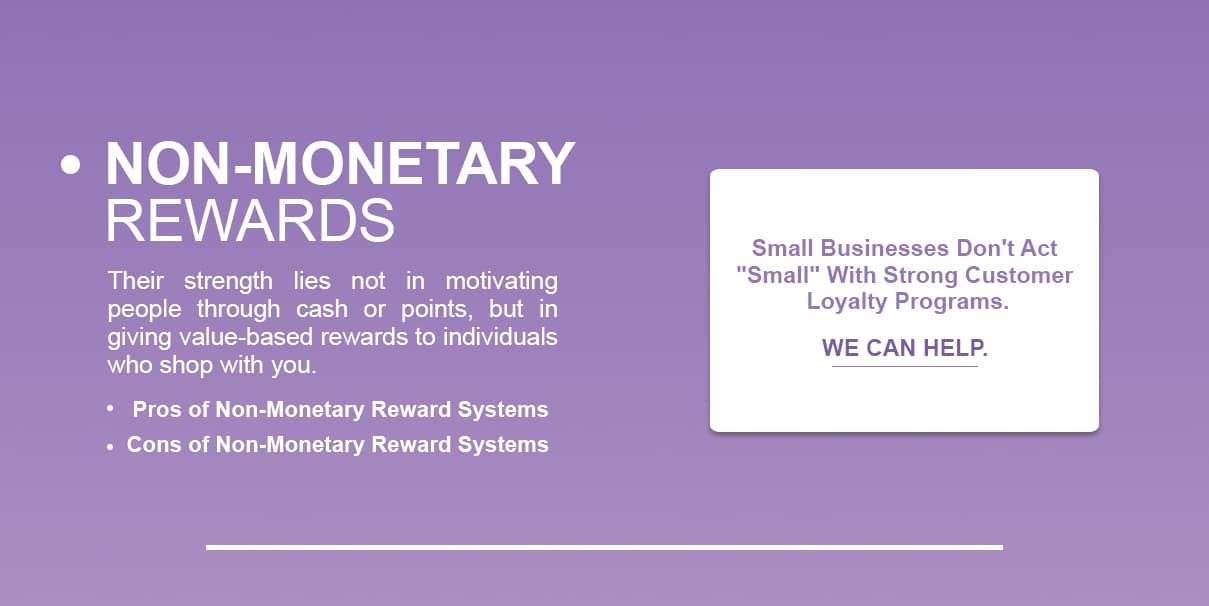
Pros of Non-Monetary Reward Systems
- Directly taps into consumers’ values and beliefs — a key to establishing genuine trust and brand commitment
- Matches lifestyles and associates your small business with someone’s everyday sense of self
- Shows the authenticity of your business beyond merely making money — especially attractive for small or family-owned businesses, which can use non-monetary perks to build a stronger altruistic identity, highlight community involvement and show how much they put people first.
Cons of Non-Monetary Reward Systems
- They must connect with a target audience that values what you’re incentivizing — otherwise, the initiative falls flat
- Can be challenging to gain early momentum to see the widespread impact of your non-monetary reward program
- Can fall out of touch with what your local consumers really want from their places of business
9. Consumer Packaged Goods (CPG) Coupon Programs
Last but not least, consumer packaged goods (CPG) coupon programs round out the ways your small business can leverage loyalty and build a larger, stronger customer base.
Large CPG companies consistently offer nationwide coupons that can be claimed at any store. Small businesses can take advantage of coupon programs by selling the items manufactured by CPGs when there are active coupons for these items. This is attractive because CPG companies make the items that your customers know the best. Think of items like Coca-Cola, Pepsi, Red Bull, Poland Spring, Doritos…These are the hottest selling items on the market. And the best part? CPG companies will cover the cost of the coupons!
There are coupon aggregators that offer customers a database of printable CPG coupons. Customers can then bring those printed coupons to your store and use them there if you store sells the products listed on the coupons. Other companies like National Retail Solutions created their own nationwide coupon program that your store can join when you buy their POS system.
Pros of CPG Discounts
- Practical and easy to join
- Rewards customers for basic purchases, making it likely they’ll return to your store for their staple shopping
- No loss of profits or revenue from the discounted items you sell
- No extra work for you, since everything is connected automatically to your point-of-sale system
Cons of CPG Discounts
- Can only offer discounts on items chosen for you that week or month
- Customers must know your small business is part of a CPG BR discount club
- Customers must readily see the discounted items advertised to know what they can buy that week
Small Businesses Don’t Act Small With Strong Customer Loyalty Programs. We Can Help.
Reward your customers for shopping at your store, and they’ll keep on doing it. Make it simple and easy for your customers to earn rewards and save money, and your business will truly stand out!
Contact National Retail Solutions today to discuss our all-in-one Point of Sale system and how it can make your customers’ shopping experience even better. Our Point of Sale (POS) Bundle is an industry leader. The POS bundle includes everything necessary for a fast and easy checkout, including state-of-the-art software, heavy-duty hardware and integration with the BR Club™ store loyalty program. BR Club™ is a creative rewards system that makes it easier to deliver the goods and services your customers want — and be the small business they return to, time and time again.


